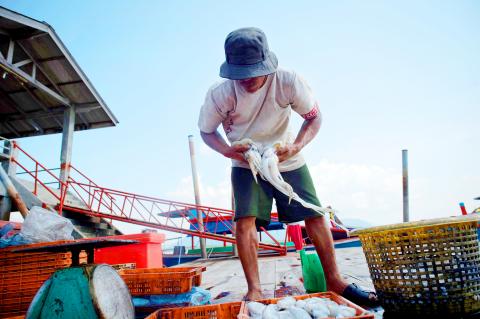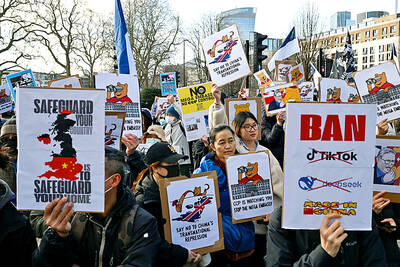As he gently lowers a fishing net into an azure lagoon, Saponkit Klatalay concedes he no longer roams the waters for days and nights like generations of sea gypsies before him, but prefers to sleep on the Thai mainland, where he was resettled after the 2004 tsunami.
His village of Chao Lay sea people drew on their ancestors’ knowledge to survive the deadly waves, but the disaster has also thrust modernity upon his community and hastened their drift from the centuries-old seafaring traditions that saved their lives.
After securing the trap for his next catch, Saponkit points toward a line of wooden houses on stilts skirting the shore of tiny Koh Phra Thong, his former island home off southwestern Phang Nga Province.

Photo: AFP
“All you can see is new. When the tsunami struck, all of this was destroyed,” said the 36-year-old, who was evacuated to the mainland Khura Buri district about 10km away, after the disaster that killed 5,395 people in Thailand alone.
Scores of houses and fishing boats were decimated, but he said all 500 Chao Lay — a marginalized group of once-nomadic hunter-gatherers — survived in his village after spotting early tsunami signs thanks to the stories imparted by village elders.
Saponkit said reading the signs gave him time to find his children, warn neighbors and race toward the center of the island to escape waves towering as high as 4m.
On the worse-hit western and southern sides of the isle, more than 100 others died — mostly Thais and Burmese migrants, but also a few foreign tourists and Chao Lay.
Thailand’s estimated 12,000 Chao Lay belong to three different ethnic groups — the Moken, the Moklen and the Urak Lawoi — who once led nomadic lives navigating the seas off the Andaman Coast, but have increasingly adopted new jobs on the mainland, where they often face discrimination.
Even those still living off the sea have become more sedentary in recent decades, with Moklen families — such as Saponkit’s — building houses along island coasts, using them as a base from which to trawl the ocean for fish, shrimps and sea cucumbers in trips that sometimes last a week. Since the tsunami, when most families from his village were resettled in gleaming new charity-built houses in Khura Buri and granted their first-ever land deeds, Saponkit only fishes for one day at a time.
He supplements his fishing income of less than 5,000 Thai baht (US$150) a month with odd jobs, such as gardening on the mainland — and recently as chairman of the council on his former island home.
“If there was no tsunami, I would never have become a local government official, because Chao Lay were looked down upon,” said Saponkit, who prefers mainland life for the educational opportunities it gives his three children.
The pale-blue village school where he once studied, extended by two stories with the donations that poured in after the tsunami, teaches pupils up to the age of 15.
Yet the new classrooms stand deserted as numbers plummeted when the Chao Lay departed en masse a decade ago.
Of the three Chao Lay groups, the more traditional Moken — skilled free-divers who, unlike other humans, can focus underwater without masks — are the best-known after they caught international headlines for saving tourists as well as themselves during the 2004 tsunami.
After interpreting the signs of the impending wave, some urged holidaymakers to flee to higher ground, while those who were ferrying tourists on boat trips moved to deeper waters, which they sensed would be safer than the shore.
The burgeoning profile of Chao Lay traditional knowledge, passed down orally through the generations, prompted the Thai Cabinet in 2010 to pass a resolution setting out a policy to protect their way of life.
However, experts say that while the move has helped to revive sea gypsy dance and music, it has done little to promote indigenous knowledge.
“It has been proved by the tsunami they knew things we did not. There is much more we can learn from them,” said Narumon Hinshiranan, an anthropologist at Chulalongkorn University in Bangkok.
The rise of mass tourism, a ban on hunting in newly protected marine parks and the depletion of fish stocks have made it increasingly difficult for Chao Lay to maintain traditional lifestyles.
Yet despite the challenges semi-nomadic communities persist — the Moken moored on the Surin islands were also evacuated to nearby Khura Buri after the tsunami — but failing to adjust to modern life, they quickly returned home.
Inside their detached houses in Thepparat village, where some of the island-living Chao Lay were resettled, other tsunami evacuees are embracing newfound creature comforts.
Fears over losing their traditions, for this group of Chao Lay at least, appear to be trumped by the security of modern life.

‘SHORTSIGHTED’: Using aid as leverage is punitive, would not be regarded well among Pacific Island nations and would further open the door for China, an academic said New Zealand has suspended millions of dollars in budget funding to the Cook Islands, it said yesterday, as the relationship between the two constitutionally linked countries continues to deteriorate amid the island group’s deepening ties with China. A spokesperson for New Zealand Minister of Foreign Affairs Winston Peters said in a statement that New Zealand early this month decided to suspend payment of NZ$18.2 million (US$11 million) in core sector support funding for this year and next year as it “relies on a high trust bilateral relationship.” New Zealand and Australia have become increasingly cautious about China’s growing presence in the Pacific

Indonesia’s Mount Lewotobi Laki-Laki yesterday erupted again with giant ash and smoke plumes after forcing evacuations of villages and flight cancelations, including to and from the resort island of Bali. Several eruptions sent ash up to 5km into the sky on Tuesday evening to yesterday afternoon. An eruption on Tuesday afternoon sent thick, gray clouds 10km into the sky that expanded into a mushroom-shaped ash cloud visible as much as 150km kilometers away. The eruption alert was raised on Tuesday to the highest level and the danger zone where people are recommended to leave was expanded to 8km from the crater. Officers also

The team behind the long-awaited Vera Rubin Observatory in Chile yesterday published their first images, revealing breathtaking views of star-forming regions as well as distant galaxies. More than two decades in the making, the giant US-funded telescope sits perched at the summit of Cerro Pachon in central Chile, where dark skies and dry air provide ideal conditions for observing the cosmos. One of the debut images is a composite of 678 exposures taken over just seven hours, capturing the Trifid Nebula and the Lagoon Nebula — both several thousand light-years from Earth — glowing in vivid pinks against orange-red backdrops. The new image

ESPIONAGE: The British government’s decision on the proposed embassy hinges on the security of underground data cables, a former diplomat has said A US intervention over China’s proposed new embassy in London has thrown a potential resolution “up in the air,” campaigners have said, amid concerns over the site’s proximity to a sensitive hub of critical communication cables. The furor over a new “super-embassy” on the edge of London’s financial district was reignited last week when the White House said it was “deeply concerned” over potential Chinese access to “the sensitive communications of one of our closest allies.” The Dutch parliament has also raised concerns about Beijing’s ideal location of Royal Mint Court, on the edge of the City of London, which has so